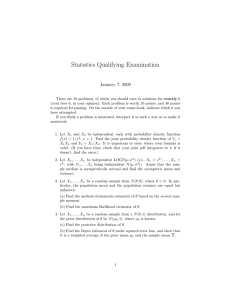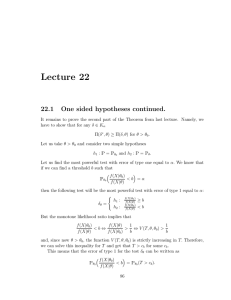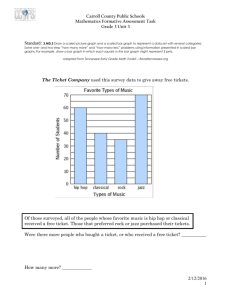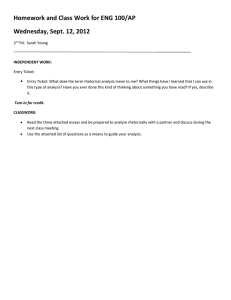Chapter 7 Dynamic Programming and Filtering. 7.1
advertisement
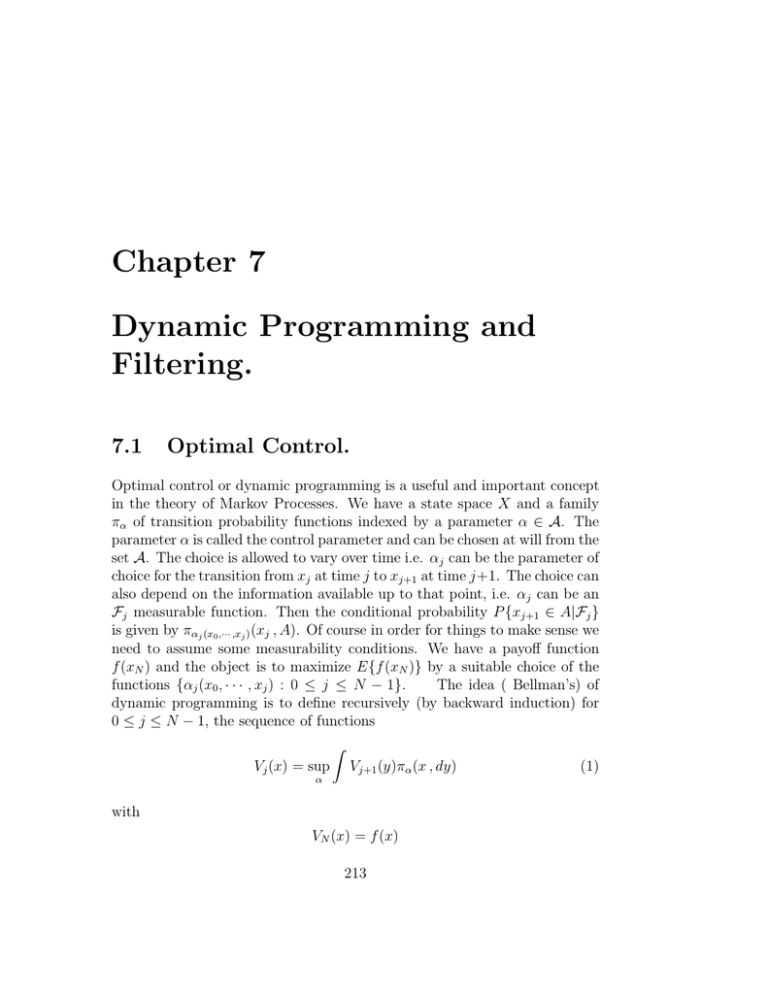
Chapter 7
Dynamic Programming and
Filtering.
7.1
Optimal Control.
Optimal control or dynamic programming is a useful and important concept
in the theory of Markov Processes. We have a state space X and a family
πα of transition probability functions indexed by a parameter α ∈ A. The
parameter α is called the control parameter and can be chosen at will from the
set A. The choice is allowed to vary over time i.e. αj can be the parameter of
choice for the transition from xj at time j to xj+1 at time j+1. The choice can
also depend on the information available up to that point, i.e. αj can be an
Fj measurable function. Then the conditional probability P {xj+1 ∈ A|Fj }
is given by παj (x0 ,··· ,xj ) (xj , A). Of course in order for things to make sense we
need to assume some measurability conditions. We have a payoff function
f (xN ) and the object is to maximize E{f (xN )} by a suitable choice of the
functions {αj (x0 , · · · , xj ) : 0 ≤ j ≤ N − 1}.
The idea ( Bellman’s) of
dynamic programming is to define recursively (by backward induction) for
0 ≤ j ≤ N − 1, the sequence of functions
Z
Vj (x) = sup
Vj+1 (y)πα (x , dy)
α
with
VN (x) = f (x)
213
(1)
214
CHAPTER 7. DYNAMIC PROGRAMMING AND FILTERING.
as well as the sequence {αj∗(x) : 0 ≤ j ≤ N − 1} of functions that provide
the supremum in (1).
Z
Z
Vj (x) = Vj+1 (y)πα∗j (x) (x , dy) = sup Vj+1 (y)πα (x , dy)
α
We then have
Theorem 7.1. If the Markov chain starts from x at time 0, then V0 (x) is
the best expected value of the reward. The ‘optimal’ control is Markovian
and is provided by {αj∗ (xj )}.
Proof. It is clear that if we pick the control as αj∗ then we have an inhomogeneous Markov chain with transition probability
πj, j+1 (x , dy) = παj (x) (x , dy)
and if we denote by Px∗ , the process corresponding to it that starts from the
point x at time 0, we can establish by induction that
∗
E Px {f (xN )|FN −j } = VN −j (xN −j )
for 1 ≤ j ≤ N. Taking j = N, we obtain
∗
E Px {f (xN )} = V0 (x).
To show that V0 (x) is optimal, for any admissible (not necessarily Markovian)
choice of controls, if P is the measure on FN corresponding to a starting point
x,
E P {Vj+1(xj+1 )|Fj } ≤ Vj (xj )
and now it follows that
E P {f (xN )} ≤ V0 (x).
Exercise 7.1. The problem could be modified by making the reward function
equal to
N
X
P
E {
fj (αj−1 , xj )}
j=0
and thereby incorporate the cost of control into the reward function. Work
out the recursion formula for the optimal reward in this case.
7.2. OPTIMAL STOPPING.
7.2
215
Optimal Stopping.
A special class of optimization problems are called optimal stopping problems. We have a Markov chain with transition probability π(x, dy) and time
runs from 0 to N. We have the option to stop at any time based on the
history up to that time. If we stop at time k in the state x, the reward
is f (k , x), The problem then is to maximize Ex {f (τ , xτ )} over all stopping
times 0 ≤ τ ≤ N. If V (k , x) is the optimal reward if the game starts from
x at time k, the best we can do starting from x at time k − 1 is is to earn a
reward of
Z
V (k − 1 , x) = max[f (k − 1 , x), V (k , y)π(x, dy)]
Starting with V (N , x) = f (N , x), by backwards induction, we can get
V (j , x) for 0 ≤ j ≤ N. The optimal stopping rule is given by
τ̄ = {inf k : V (k , xk ) = f (k , xk )}
Theorem 7.2. For any stopping time τ with 0 ≤ τ ≤ N,
Ex {f (τ , xτ )} ≤ V (0 , x)
and
Ex {f (τ̄ , xτ̄ )} = V (0 , x)
Proof. Because
Z
V (k , x) ≥
V (k + 1 , y)π(x , dy)
we conclude that V (k , xk ) is a supermartingale and and an application
of Doob’s stopping theorem proves the first claim. On the other hand if
V (k , x) > f (k , x), we have
Z
V (k , x) = V (k + 1 , y)π(x , dy)
and this means V (τ̄ ∧ k , xτ̄ ∧k ) is a martingale and this establishes the second
claim.
216
CHAPTER 7. DYNAMIC PROGRAMMING AND FILTERING.
Example 7.1. (The Secretary Problem.) An interesting example is the following game.
We have a lottery with N tickets. Each ticket has a number on it. The
numbers a1 · · · , aN are distinct, but the player has no idea of what they
are. The player draws a ticket at random and looks at the number. He
can either keep the ticket or reject it. If he rejects it, he can draw another
ticket from the remaining ones and again decides if he wants to keep it. The
information available to him is the numbers on the tickets he has so far drawn
and discarded as well as the number on the last ticket that he has drawn and
is holding. If he decides to keep the ticket at any stage, then the game ends
and that is his ticket. Of course if he continues on till the end, rejecting all
of them, he is forced to keep the last one. The player wins only if the ticket
he keeps is the one that has the largest number written on it. He can not
go back and claim a ticket that he has already rejected and he can not pick
a new one unless he rejects the one he is holding. Assuming that the draws
are random at each stage, how can the player maximize the probability of
winning? How small is this probability?
It is clear that the strategy to pick the first or the last or any fixed draw
has the probability of N1 to win. It is not apriori clear that the probability pN
of winning under the optimal strategy remains bounded away from 0 for large
N. It seems unlikely that any strategy can pick the winner with significant
probability far large values of N. Nevertheless the following simple strategy
shows that
1
lim inf pN ≥ .
N →∞
4
Let half the draws go by, no matter what, and then pick the first one which
is the highest among the tickets drawn up to the time of the draw. If the
second best has already been drawn and the best is still to come, this strategy
will succeed. This has probability nearly 14 . In fact the strategy works if the
k best tickets have not been seen during the first half, (k + 1)-th has been
and among the k best the highest shows up first in the second half. The
1
probability for this is about k2k+1
, and as these are disjoint events
lim inf pN ≥
n→∞
X
k≥1
1
1
= log 2
k+1
k2
2
If we decide to look at the first Nx tickets rather than N2 , the lower bound
becomes x log x1 and an optimization over x leads to x = 1e and the resulting
7.2. OPTIMAL STOPPING.
217
lower bound
1
lim inf pN ≥ .
n→∞
e
We will now use the method optimal stopping to decide on the best
strategy for every N and show that the procedure we described is about the
best. Since the only thing that matters is the ordering of the numbers, the
numbers themselves have no meaning. Consider a Markov chain with two
states 0 and 1. The player is in state 1 if he is holding the largest ticket so far.
Otherwise he is in state 0. If he is in state 1 and stops at stage k, i.e. when
k tickets have been drawn, the probability of his winning is easily calculated
to be Nk . If he is in state 0, he has to go on and the probability of landing on
1
1 at the next step is calculated to be k+1
. If he is at 1 and decides to play on
1
the probability is still k+1 for landing on 1 at the next stage. The problem
reduces to optimal stopping for a sequence X1 , X2 , · · · , XN of independent
i
random variables with P {Xi = 1} = 1i + 1, P {Xi = 0} = i+1
and a reward
i
function of f (i , 1) = N ; f (i , 0) = 0. Let us define recursively the optimal
probabilities
V (i , 0) =
1
i
V (i + 1, 1) +
V (i + 1 , 0)
I +1
i+1
and
V (i , 1) = max[
i
1
i
i
,
V (i + 1, 1) +
V (i + 1 , 0)] = max[ , V (i , 0)]
N I +1
i+1
N
It is clear what the optimal strategy is. We should draw always if we are in
state 0, i.e. we are sure to lose if we stop. If we are holding a ticket that is
the largest so far, we should stop provided
i
> V (i , 0)
N
and go on if
i
< V (i , 0).
N
Either startegy is acceptable in case of equality. Since V (i+1 , 1) ≥ V (i+1 , 0)
for all i, it follows that V (i , 0) ≥ V (i + 1, 0). There is therefore a critical
k(= kN ) such that Ni ≥ V (i , 0) if i ≥ k and Ni ≤ V (i , 0) if i ≤ k. The best
strategy is to wait till k tickets have been drawn, discarding every ticket,
CHAPTER 7. DYNAMIC PROGRAMMING AND FILTERING.
218
and then pick the first one that is the best so far. The last question is the
determination of k = kN . For i ≥ k,
V (i , 0) =
1 i+1
i
1
i
+
V (i + 1 , 0) =
+
V (i + 1 , 0)
i+1 N
i+1
N
i+1
or
V (i , 0) V (i + 1 , 0)
1 1
−
=
·
i
i+1
N i
telling us
N −1
i X1
V (i , 0) =
N j=i j
so that
N −1
1
1 X1
kN = inf i :
<
N j=i j
N
Approximately log N − log kN = 1 or kN =
7.3
N
.
e
Filtering.
The problem in filtering is that there is an underlying stochastic process
that we cannot observe. There is a related stochastic process ‘driven’ by
the first one that we can observe and we want to use our information to
make conclusions about the state of the unobserved process. A simple but
extreme example is when the unobserved process does not move and remains
at the same value. Then it becomes a parameter. The driven process may
be a sequence of i.i.d random variables with densities f (θ, x) where θ is
the unobserved, unchanging underlying parameter. We have a sample of n
independent observations X1 , · · · , Xn from the common distribution f (θ, x)
and our goal is then nothing other than parameter estimation. We shall take
a Bayesian approach. We have a prior distribution µ(dθ) on the space of
parameters Θ and this can be modified to an ‘aposteriori’ distribution after
the sample is observed. We have the joint distribution
n
Y
i=1
f (θ, xi ) dxi µ(dθ)
7.3. FILTERING.
219
and we calculate the conditional distribution of
µn (dθ|x1 · · · xn )
given x1 , · · · , xn . This is our best informed guess about the nature of the
unknown parameter. We can use this information as we see fit. If we have an
additional observation xn+1 we need not recalculate everything, but we can
simply update by viewing µn as the new prior and calculating the posterior
after a single observation xn+1 .
We will just work out a single illustration of this known as the KallmanBucy filter.
Suppose {xn } the unobserved process is a Gaussian Markov
chain
xn+1 = ρxn + σξn+1
with 0 < ρ < 1 and the noise term ξn are i.i.d normally distributed random
variables with mean 0 and variance 1. The observed process yn is given by
yn = xn + ηn
where the {ηj } are again independent standard Gaussians that are independent of the {ξj } as well. If we start with an initial distribution for x0 say one
that is Gaussian with mean m0 and variance σ02 , we can compute the joint
distribution of x0 , x1 and y1 and then the conditional of x1 given y1 . This
becomes the new distribution of the state x1 based on the observation y1 .
This allows us te calculate recursively at every stage.
Let us do this explicitly now. The distribution of x1 , y1 is jointly normal
with mean (ρm0 , ρm0 ) variances (ρ2 σ02 + σ 2 , ρ2 σ02 + σ 2 + 1) and covariance
(ρ2 σ02 + σ 2 ). The posterior distribution of x1 is again Normal with mean
(ρ2 σ02 + σ 2 )
(y1 − ρm0 )
(ρ2 σ02 + σ 2 + 1)
1
(ρ2 σ02 + σ 2 )
= 2 2
m
)y1
+
0
(ρ σ0 + σ 2 + 1)
(ρ2 σ02 + σ 2 + 1
m1 = ρm0 +
and variance
σ12 = (ρ2 σ02 + σ 2 )(1 −
=
(ρ2 σ02 + σ 2 )
(ρ2 σ02 + σ 2 + 1)
(ρ2 σ02 + σ 2 )
(ρ2 σ02 + σ 2 + 1)
220
CHAPTER 7. DYNAMIC PROGRAMMING AND FILTERING.
After a long time while the recursion for mn remains the same
mn =
1
(ρ2 σ02 + σ 2 )
+
m
)yn
n−1
(ρ2 σ02 + σ 2 + 1)
(ρ2 σ02 + σ 2 + 1
2
the variance σn2 has an asymptotic value σ∞
given by the solution of
2
σ∞
=
2
+ σ2 )
(ρ2 σ∞
.
2 + σ 2 + 1)
(ρ2 σ∞
